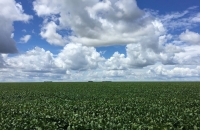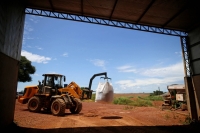When Brazilian farmer Ricardo Santinoni first planted soybeans in the central state of Goias, he could only afford to sow about 70 hectares. Two decades on, he has 1,000. And he did it without cutting down a single tree.
The land Santinoni took over from his father was a degraded cattle-grazing pasture — once part of Brazil's vast Cerrado tropical savanna — cleared decades ago and then abandoned when it became unproductive.
But over the years, Santinoni and his partner Fernanda Ferreira, an agronomist, have gradually brought it back to a fertile condition by rotating other crops such as corn or beans and grazing cattle on it to enrich the soil with manure.
"I see myself as a small part of a giant whole," Santinoni said in his office at the Morro do Peao farm, gesturing to a red plaque hanging on the wall that sums up their mission: "Feed Life in a Sustainable Way."
Soy farming, closely linked to deforestation, has seldom been synonymous with sustainability, but Santinoni said more and more farmers were working to regenerate depleted land instead of expanding the agricultural frontier.
Their push reflects growing global concern about deforestation to make way for the crop in Brazil, the world's biggest producer of soy — used to feed Europe's livestock and make cooking oil for big Asian markets such as India and China.
In 2006, soy traders voluntarily agreed to stop buying soy from areas deforested in the Amazon after a certain date. Since then, soy farming has expanded rapidly in other areas including the Cerrado, where environmental advocates want a similar pact.
Goias is Brazil's third-largest soy-producing state. Cities like Pires do Rio — where Morro do Peao is located — are encircled by farmland where soy, corn and other crops are grown year-round on rolling plains that stretch toward low hills on the horizon.
During the dry months from May to September, the rural landscape turns yellow and brown after the main soy crop has been brought in, withered stems littering the parched soils.
But at Morro do Peao, in August, there is still plenty of green from beans in some fields and from grass in others, where the farm's roughly 1,000 cattle graze.
Pointing to the verdant fields around him, Santinoni said no rain had fallen here for three months.
"I'm contributing a lot to the sustainability of the planet with the practices we have on the property," the 49-year-old said after wrapping up a weekly meeting with his employees that focused on reducing waste and keeping the farm clean.
Food vs. nature
Brazil has overtaken the United States in recent years as the world's biggest soy producer, with its farmers gathering a record harvest of 155 million metric tons in 2023, according to the U.S. Department of Agriculture (USDA).
About 45 million hectares — an area roughly the same size as Sweden — are used to grow the oilseed.
But on top of that, Brazil has about 100 million hectares of degraded pastures, according to a government estimate, lands that could potentially be brought back into production for soybeans or other food crops.
While land regeneration has been done for decades in the country, the practice has gained traction as an alternative to clearing more land for agriculture as governments around the world seek to tackle global warming.
Deforestation is fueling climate change impacts — including harsher heat, drought and floods, which can slash harvests and spur new pests, posing a growing threat to global food security.
That makes efforts like land regeneration that seek to balance nature protection and farming all the more urgent, especially in areas like the Cerrado — the world's most biodiverse savanna — where deforestation has been rising.
Brazil's government announced plans in July to create a fund for restoration. The aim is to gather about $120 billion from investors, which would allow for 40 million hectares to be restored over the next decade, according to an August report in the business newspaper Valor Economico.
"We have the technology to make these areas productive again," said Marcia Mascarenhas Grise, a researcher at Embrapa, Brazil's agricultural research corporation.
"We don't need to open new areas (for agriculture)."
Stopping deforestation
At Morro do Peao, soy yields have steadily ticked up despite reductions in the use of chemical fertilizers, illustrating the effectiveness of their approach, Ferreira said.
In 2004, they harvested an average of 49 60-kg sacks of soybeans per hectare. Now, they gather 75 sacks per hectare and hope to reach 100 sacks by 2026.
Crop rotation is central to their land management technique, and the practice includes planting grass for cattle grazing — saving on feed and keeping the animals healthier, Ferreira said as she walked in the fields alongside the cattle.
Restoring land and increasing productivity is vital to avoiding further deforestation, said Priscila Souza, head of policy evaluation at the Climate Policy Initiative (CPI), a nonprofit that works in Brazil alongside PUC-Rio, the Pontifical Catholic University of Rio de Janeiro.
Continued tree clearance in the Amazon even poses a threat to the country's agricultural production by leading to lower rainfall in key soy-growing areas in the south of the country, CPI/PUC-Rio research has found.
"In the 2021/22 agricultural year, we had such a severe drought that (insurance claims) increased almost four times compared to the previous harvest," Souza said.
But despite the promise of land restoration as a way to protect Brazil's forests, she said government assistance will be needed, especially for small-holders who tend to have less capital and technical expertise.
"For small-holders, restoration is uncertain and costly," she said.
Cultural change
Even without direct government incentives, it often makes economic sense for Brazilian farmers to restore their lands, and investment firms have started looking for opportunities.
"There's a very simple explanation for that: it's a lot cheaper for a farmer to convert a degraded area than to open a new (legally deforested) one," said Pedro Henrique de Alcantara, an analyst at Embrapa.
Paramis Capital, a Brazilian financial services company, is structuring a 500-million reais ($100.6 million) fund to buy up degraded land and restore it.
Structuring funds to buy up land is not uncommon, but usually firms just buy land and then lease it back to farmers, said Silvio Valle, from Paramis.
But Paramis aims to restore and manage the land itself through a partnership with Fisalis, a resource management firm that specializes in agricultural assets.
"Our thesis is transformational: we are taking up land that yields 20 sacks (of soy) per hectare, and improving that to 60 sacks," said Ricardo Scaff, an agricultural engineer and partner at Fisalis.
"It's like buying an old house, renovating it and selling it. It's better than buying and renting," Scaff added.
For Santinoni, the shift toward greater sustainability on his farm marks a turning point amid growing international pressure over deforestation and reflects a change in thinking among a new generation of farmers.
It is also about farmers' financial survival, he said, with diminishing soy yields eventually making growers uncompetitive.
"The market itself will drive him out."
























With your current subscription plan you can comment on stories. However, before writing your first comment, please create a display name in the Profile section of your subscriber account page.